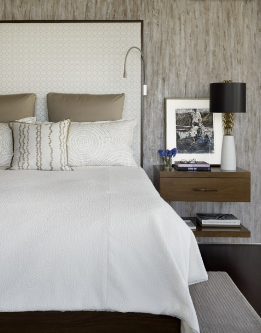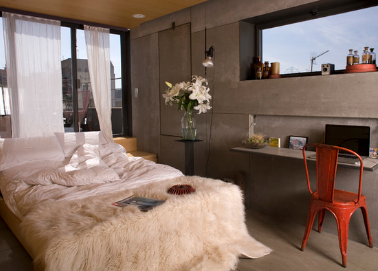The bedroom should be your refuge. Ideally, it should have enough space to store personal belongings and give you the space to relax, dream, and feel most comfortable. However, when you’re faced with limited size, it can be challenging to create a bedroom that can do all of these tasks. Often, the need for storage and functionality overshadows the desire for style. The result can be a bedroom that feels unwelcoming, cluttered, or even lifeless.
Designers often advocate integrating storage under the bed and using inclusions as a classic space-saving solution. But there are plenty of ways to make your tiny bedroom not only functional, but also chic. We offer seven solutions to small space problems that can help you create a practical haven without sacrificing style.

In a small bedroom, you have a limited surface area. So get creative and take a look at one of the things that is often overlooked: the ceiling. Hanging ornaments overhead not only frees up space underneath, but also attracts attention. This effect gives the illusion of a larger volume in a small room.
Instead of using a bedside table lamp, hang a chandelier from the ceiling. This creates an upward vertical line and opens up the space below, making the room feel brighter, uncluttered, and even more stylish.
Design tip: Chandeliers come in a variety of sizes and styles, from simple glass balls to delicate crystals, and are a great way to turn an ordinary bedroom into an extraordinary piece of paradise. Look for chandeliers with openwork or jewel-like openings. When lit in the dark, the light will glow like a jewel box in your bedroom.

Similarly, curtains can be hung from the ceiling instead of hanging on the wall above the window. The hardware design of most curtains is flexible. So, try turning the bracket up and mounting it on the ceiling. The length and vertical lines of the curtains will make the ceiling feel higher and the room larger.
Here, the designers chose not only the curtains on the ceiling, but also the same bold colors on the ceiling, giving this small room a dramatic character.
If you like the look of a roman blind, hang it on the ceiling. Pull the blackout curtain down enough to cover the top of the window. This will elongate the appearance of the window and attract the eye.

Since large furniture takes up floor area in a small bedroom, a good trick to create space and make the room look more airy is to float some furniture on the wall. This arrangement makes the furniture seem to blend into the walls, making your room look more streamlined.
Storage furniture, such as a bedside table with drawers or even a small dresser, can also be fastened to the wall to leave room for shoes or a stylish basket with essentials. Look for parts that have separate legs and keep them. DIY considerations, if you don’t use a contractor to install your parts, be sure to consult with a contractor. You need to make sure that your walls can withstand the weight and that you are using the correct braces and wall anchors.
Design tip: Look for stylish items in your living space, such as a media console that floats on the wall. The streamlined size of such pieces usually fits into a small bedroom. Plus, their cupboards and shelves are great for storing clothes and shoes.

Making the bed wall the star of the bedroom is fun for any size room. However, it is especially useful in small bedrooms, as doing so gives personality to the room and draws attention to the design features rather than the small size of the room.
There are many ideas for bed walls. If you choose an affordable option, murals, feature paint colors, and even wallpaper can all be cost-effective. Creating a gallery wall above your bed can also be a way to add a personal touch. Another idea is to show off a cool headboard.

Design tip: For unexpected headboards, use decorative elements that aren’t commonly found in the bedroom. Think painted wooden shutters, decorative wall panels that can be laid flat and fixed to the wall, or ornate iron plates painted in interesting colors. Just make sure to place an oversized pillow in front of such a unit or hang it out of reach of your head.

To maximize the use of limited floor space – especially since beds often take up most of the valuable space – use flexible furniture that folds down to the wall. You can try a folding table that doubles as a makeup table. A wall-mounted pull-out shoe cabinet in the wardrobe frees up space on the wardrobe floor for a small chest of drawers to increase the storage space you need.

The most classic bedroom folding furniture is, of course, the Murphy bed. It’s an excellent choice for an alcove in a studio apartment or a room that doubles as a study or home office. It can even be useful if you only have a small bedroom and don’t have enough functional space for storage furniture and a bed. Today’s Murphy beds are well-designed, comfortable, and often incorporate other design features, such as bookshelves or desks.
Design tip: Try adding decorative components to the outer surface of the fold. Drawing a pattern on the back of a closed table or desk will add a visually interesting element to the room.

Whether the door leads to the wardrobe or the bedroom, the door needs a gap to open and close. The clearance required may limit your choice of furniture placement and size. If this is the case in your home, consider replacing traditional doors with stylish folding doors, sliding doors, or pocket doors. They take up less space because they eliminate the swinging action of more standard options.

Another way to enhance the functionality of your bedroom doors is to replace them with filters or reflective materials. Frosted glass doors can make a small room feel less closed. Similarly, mirrored wardrobe doors can make the room feel bigger.
Design tip: Consider replacing regular door hardware with a more stylish option. Handles and knobs made of plexiglass, modern brushed brass or polished chrome can give a room a renewed feel. For a more cohesive, designer look, coordinate the door hardware with the drawer handles.

Mirrors are the best friend in a small bedroom. Medium- to large-sized mirrors can be placed almost anywhere – there are no strict rules. You can try it above the headboard or floating vanity, on the wall facing the bed, or as part of a mirrored wardrobe door. Mirrors will not only make a room appear larger, but they will also reflect any natural light you have.

Design tip: Use multiple mirrors on the walls of your art venue. Galleries of mirrors of different shapes and sizes can serve as wonderful feature walls while making the room feel bigger. Or try leaning an oversized tilting mirror against the wall. Its huge size will make the room feel bigger and brighter.

Highlighting something eye-catching in a small room will not only make a statement and style, but it will also distract people from the size of the room. So make bold choices in your bedroom. You can choose a unique paint color for your bed wall, or choose a unique wallpaper, such as a straw cloth. Other details that need attention can be a special piece of furniture, a large piece of art, or a great light fixture.
Design tip: For a bold statement that is cost-effective, use a throw pillow as the centerpiece of your room. A well-designed collection of patterns and textures that are different from the rest of the room can really steal the show. For example, in an all-white room, a series of brightly colored pillows stand out. Similarly, in a room with dark walls and bedding, try a variety of colorful patterned pillows or metallic tones for an eye-catching color palette.

